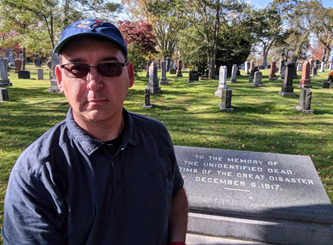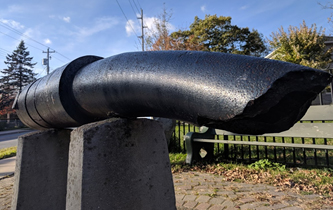
York U disaster and emergency management Associate Professor Jack Rozdilsky at Halifax St. Johns Cemetery, which hold the remains from some of the approximately 2,000 persons killed in the December 6, 1917 Halifax Harbour explosion
TORONTO, Tuesday, Dec. 5, 2017 – Even though the Halifax disaster happened 100 year ago, it still has direct effects on the people of Halifax, the descendants of the those who were alive at the time, and the city itself, says York U disaster and emergency management expert Jack Rozdilsky.
Dec. 6 marks the 100th anniversary of the Halifax explosion, Canada’s most deadly disaster in history and the largest man-made explosion on the planet, not including the first atomic bomb detonation in 1945. Sparked when the Imo, a Belgian relief ship, and the Mont-Blanc, a French munitions ship collided, resulting in everything within one kilometre being levelled – about 1,600 structures.
“What people often don’t remember about the disaster is that Halifax was hit by a blizzard that same night complicating rescue efforts and adding to people’s misery,” said Rozdilsky of York’s Faculty of Liberal Arts & Professional Studies.

A monument in Dartmouth, Nova Scotia, of the 1,200-pound cannon from the Mont-Blanc’s stern that was blasted about three kilometres away from the Halifax Harbour explosion site on Dec. 6, 1917
Some 1,600 people were killed instantly, while the final death toll surpassed 2,500. About 9,000 were injured, most from flying glass and debris, and about 6,000 were left homeless. Another 19,000 were left with inadequate shelter.
Rozdilsky, an associate professor who teaches a disaster case study course at York U and studies disaster memorialization and commemoration, can discuss the following:
- How the impacts of the Halifax disaster are still tangibly being felt 100 years later
- The importance of acknowledging disaster anniversaries
- How the Halifax disaster laid the foundation for the academic study of disasters and best practices going forward
- Why the Halifax disaster is still considered Canada’s worst disaster
- The basic facts and scale of the disaster
-30-
York University is known for championing new ways of thinking that drive teaching and research excellence. Our students receive the education they need to create big ideas that make an impact on the world. Meaningful and sometimes unexpected careers result from cross-discipline programming, innovative course design and diverse experiential learning opportunities. York students and graduates push limits, achieve goals and find solutions to the world’s most pressing social challenges, empowered by a strong community that opens minds. York U is an internationally recognized research university – our 11 faculties and 26 research centres have partnerships with 200+ leading universities worldwide. Located in Toronto, York is the third largest university in Canada, with a strong community of 53,000 students, 7,000 faculty and administrative staff, and more than 295,000 alumni. York U's fully bilingual Glendon campus is home to Southern Ontario's Centre of Excellence for French Language and Bilingual Postsecondary Education.
Media contacts:
Sandra McLean, York University Media Relations, 416-736-2100 ext. 22097, sandramc@yorku.ca

